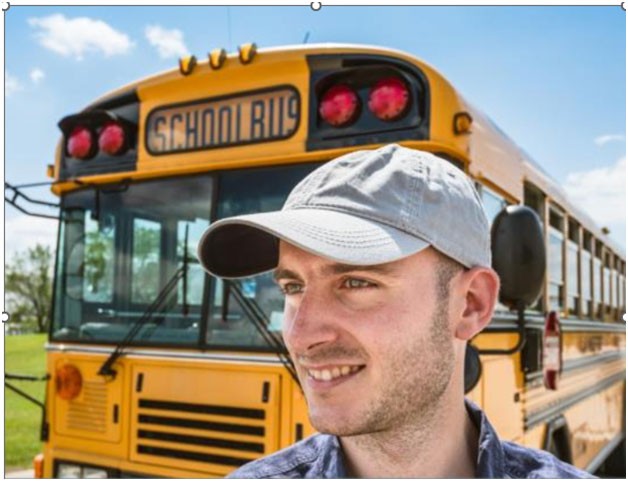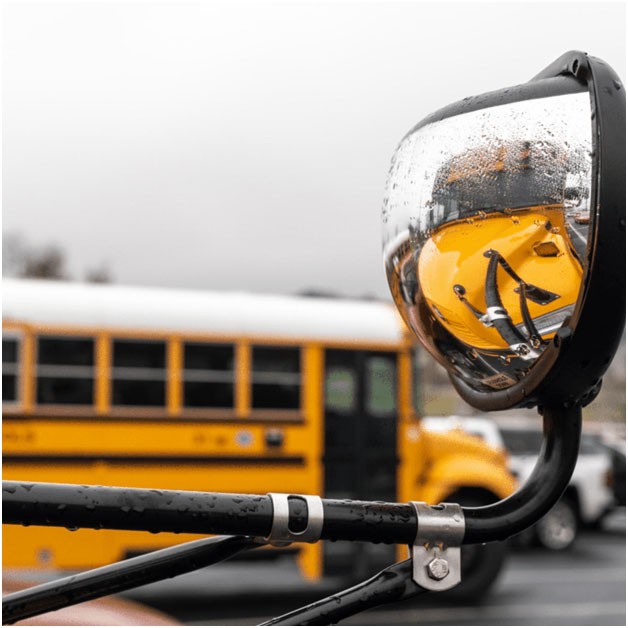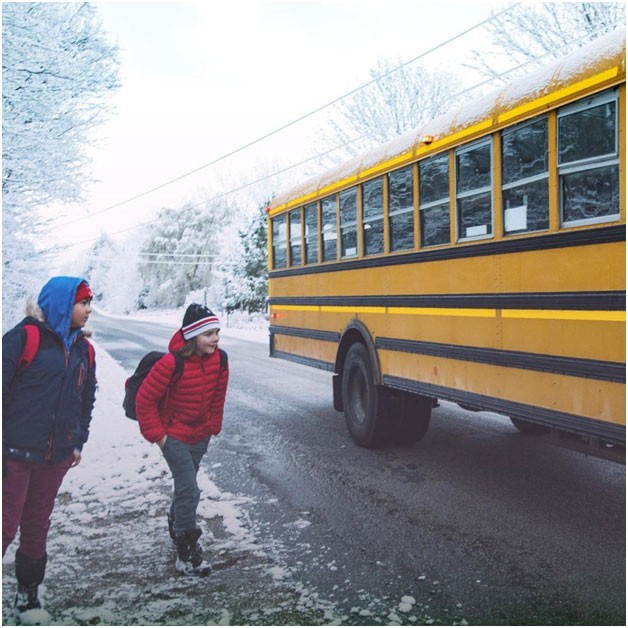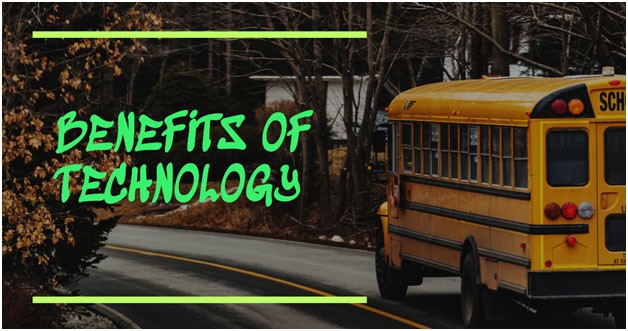
Beyond the Wheel
A Day in the Life of a School Bus Driver
It’s an hour before dawn. And while thousands of kids are just beginning to stir, an army of stalwart workers are boarding their orange-yellow behemoths. School bus drivers are a special breed. This sometimes thankless job takes a special kind of dedicated person. As we will see, the challenges are real. But so are the benefits.
According to one report, about a third of all students ride the bus to school. That represents millions of kids of all ages who must arrive safely at their destinations every school day.
Let’s familiarize ourselves with the daily tasks these unsung heroes complete for the benefit of their young riders. In doing so, we will better understand and appreciate the often-overlooked bus driver.

The Daily Routine of a School Bus Driver
Early Morning Preparations
The day for a school bus driver begins long before the sun rises. Drivers typically start their shifts early in the morning, allowing sufficient time for all necessary preparations.
Before setting off, a comprehensive vehicle safety check is conducted. This includes inspecting tires, brakes, lights, and other essential components to ensure the bus is in optimal working condition. Any issues found must be reported and addressed immediately to guarantee the safety of the students.
One of the most critical aspects of a school bus driver's morning routine is reviewing their route. Utilizing advanced routing software, drivers can easily familiarize themselves with their route, ensuring they know all stops and potential hazards. On-the-fly changes to routes are possible to accommodate adjustments in the roster of students that must be transported for the day. This kind of advanced routing software helps districts optimize routes for efficiency and safety, making the driver's job more manageable and less stressful.
Morning Pickup Route
With all preparations complete, the driver begins the morning pickup route. This involves navigating through neighborhoods and adhering to tight schedules to ensure timely arrivals at each stop.
Time management is essential for school bus drivers. They must maintain a strict schedule to pick up students promptly while ensuring they drive safely and adhere to all traffic laws. A small delay compounds and affects every stop down the line.
At each stop, drivers ensure students board safely. They greet each child with a friendly smile, creating a welcoming environment. This initial interaction sets the tone for the students' day, fostering a sense of community and trust.
Midday Responsibilities
After the morning drop-offs, a school bus driver’s responsibility may vary. During the midday break, drivers have time for lunch and some rest. However, they may also be assigned additional duties, such as transporting students for field trips or sporting events, requiring them to remain flexible and adaptable. Each day may bring new aspects to the jobs of these minor superheroes.
Drivers often take advantage of the midday lull to perform maintenance and cleaning tasks. This includes refueling the bus, checking fluid levels, and ensuring the interior is clean and safe for the afternoon route.
Afternoon Drop-Off Route
The afternoon brings a new set of challenges as the driver prepares for the drop-off route. Students are often more energetic in the afternoon, so drivers need to manage this increased activity while maintaining order and safety on the bus. Establishing clear rules and a respectful environment helps in keeping the journey smooth.
Communication with parents and schools is vital. Drivers ensure that each child is safely dropped off at their designated stop and communicate any concerns or incidents that occurred during the day.
End-of-Day Procedures
As the day ends, school bus drivers follow specific end-of-day protocols to wrap up their shifts.
A thorough final vehicle inspection is conducted to ensure the bus is in good condition for the next day. This includes checking for any left-behind belongings, securing windows and doors, and addressing any maintenance issues during the day.
Drivers complete necessary administrative tasks, such as logging their hours, reporting any incidents, and communicating with the school administration about the day's activities.
Handling Emergencies and Unexpected Situations
Even with perfect planning, emergencies and unexpected situations can arise. Whether it's a mechanical issue or a sudden change in weather conditions, drivers are trained to handle these scenarios calmly and efficiently, prioritizing student safety above all else.

Challenges Faced by School Bus Drivers
School bus drivers play a pivotal role in the education system. Responsible drivers ensure that students travel safely to and from school each day. However, this responsibility comes with a unique set of challenges that drivers must navigate daily. Consider some of the most significant challenges faced by school bus staff and how they overcome them while maintaining a positive atmosphere.
Weather-Related Obstacles
Weather conditions can dramatically impact a school bus driver’s day. Whether it's heavy rain, snow, ice, or fog, adverse weather poses significant risks. Slippery roads require careful driving, extended stopping distances, and slower speeds, all of which can delay routes and increase the risk of accidents. Drivers must be well-prepared and trained to handle these conditions, often adjusting their schedules and routes to ensure safety.
Innovative technology packages that integrate with weather systems help by providing real-time updates and alternative routes to navigate weather-related obstacles more efficiently.
Traffic and Road Construction Issues
Traffic congestion and road construction are common issues that can disrupt a school bus driver's schedule. Traffic jams, detours, and closed roads require quick thinking and flexible planning. Drivers must stay informed about local road conditions and be ready to adapt their routes on the go.
Student Behavior Management
Managing student behavior is one of the most challenging aspects of a school bus driver’s job. With a bus full of energetic and sometimes unruly children, drivers must maintain order and ensure everyone follows safety rules.
Disruptive behavior can distract drivers and pose safety risks. Effective behavior management strategies, clear communication of rules, and building rapport with students are essential goals.
Additionally, drivers should receive training in conflict resolution and student behavior management to help them handle these situations effectively.
Time Pressure and Scheduling Conflicts
School bus drivers operate under strict time constraints. They must adhere to tight schedules to ensure students arrive at school and home on time. Traffic delays, road construction, and weather conditions can all contribute to scheduling conflicts, adding pressure to the driver's day.
Responsibility for Passenger Safety
The primary responsibility of a school bus driver is the safety of their passengers. This includes ensuring that students board and exit the bus safely, remain seated during transit, and follow all safety protocols. Drivers must always be vigilant. This requires constant monitoring of their surroundings and the behavior of the students. This immense responsibility requires a high level of focus, patience, and dedication. It can mentally taxing.
Balancing Challenges with Maintaining a Positive Atmosphere
Despite the numerous challenges, school bus drivers strive to maintain a positive atmosphere on their buses. Creating a friendly and welcoming environment helps in managing student behavior and making the daily commute more pleasant for everyone.
Drivers often go above and beyond, greeting each child with a smile, engaging in friendly conversations, and fostering a sense of community. This positive atmosphere not only makes the journey enjoyable but also contributes to a safer and more orderly bus environment.

The Rewards of Being a School Bus Driver
While the role of a school bus driver comes with its share of challenges, it also offers numerous rewards. These dedicated professionals enjoy unique benefits that make their jobs fulfilling and impactful. Here, we highlight some of the most significant rewards of being a school bus driver.
Building Relationships with Students
One of the most rewarding aspects of being a school bus driver is the opportunity to build meaningful relationships with students. Drivers see the same children every day, watching them grow and develop over the years. These interactions allow drivers to become trusted adults in the lives of their passengers, offering a friendly smile, a listening ear, and a sense of security. These relationships often lead to a deep sense of satisfaction and personal connection.
Contributing to Community Safety and Well-being
School bus drivers play a crucial role in ensuring the safety and well-being of their communities. By transporting students safely to and from school, they help reduce traffic congestion and the risk of accidents around schools. Their presence contributes to a safer environment for everyone.
Flexible Work Schedule
The nature of a school bus driver's job often allows for a flexible work schedule. Many drivers work split shifts, with a break in the middle of the day. This schedule can be ideal for those who have other commitments or prefer having free time during the day. It also offers opportunities for part-time work, making it a great option for retirees, parents, or individuals seeking additional income.
Job Stability and Benefits
Being a school bus driver often comes with job stability and benefits. As a critical part of the education system, the demand for school bus drivers remains consistent. Many drivers are employed by school districts or private transportation companies that offer competitive salaries, health insurance, retirement plans, and other benefits. This stability provides peace of mind and financial security.
Sense of Purpose in Child Education Support
School bus drivers play an integral role in the education system by ensuring that students arrive at school ready to learn. This responsibility gives drivers a sense of purpose and fulfillment, knowing they are contributing to the educational support of children. By providing safe and reliable transportation, they help students access the education they need to succeed.
Becoming a Respected Figure in the Community
School bus drivers often become respected figures in their communities. Their dedication to safety and the well-being of children earns them admiration and gratitude from parents, teachers, and school administrators.
This respect extends beyond the school community, as drivers are recognized for their commitment and hard work. Many drivers find that their role allows them to positively impact their community.

Qualifications and Training
Becoming a school bus driver involves a rigorous process to ensure that only the most qualified and dedicated individuals are entrusted with the responsibility of transporting students safely. Let’s look at some of the qualifications and training processes for school bus drivers.
Required Licenses and Certifications
To become a school bus driver, candidates must obtain a Commercial Driver’s License (CDL) with a Passenger (P) endorsement and a School Bus (S) endorsement. The CDL ensures that drivers have the necessary skills to operate large vehicles safely. The P and S endorsements are specifically tailored to the unique requirements of transporting passengers and school children.
In addition to the CDL, many states require school bus drivers to complete specialized training programs. These programs cover a wide range of topics, including student management, emergency procedures, and defensive driving techniques. Certification typically involves both classroom instruction and practical, on-the-road training.
Background Checks and Drug Testing
Ensuring the safety of students is paramount, so thorough background checks are mandatory for all prospective school bus drivers. These checks typically include criminal history, driving record, and references. Any history of violent crime, drug offenses, or serious traffic violations can disqualify a potential driver.
School bus drivers must undergo pre-employment drug testing, and they are subject to random drug and alcohol testing throughout their employment. This stringent testing protocol helps maintain a drug-free workplace and ensures that drivers are in the best state to perform their duties safely.
Ongoing Training and Skill Development
The training for school bus drivers does not end once they receive their initial certification. Continuous education is crucial to keep drivers updated on the latest safety protocols, regulations, and best practices. Many school districts and transportation companies require periodic refresher courses.
Beyond mandatory training, drivers are encouraged to develop their skills through workshops, seminars, and professional development courses. Topics may include:
- Advanced defensive driving techniques
- First aid and CPR
- Strategies for managing student behavior
How Qualifications Contribute to Safety and Professionalism
The rigorous qualification process for school bus drivers directly contributes to the safety of students. By requiring specialized licenses, thorough background checks, and ongoing training, school districts ensure that only highly skilled and responsible individuals are behind the wheel. This comprehensive approach minimizes the risk of accidents and ensures that drivers are equipped to handle emergencies effectively.
High standards of qualification and training also enhance the professionalism of school bus drivers. These standards instill a sense of pride and responsibility in drivers, fostering a professional attitude toward their role. Drivers who are well-trained and highly qualified are more likely to approach their job with the seriousness and dedication it deserves.

Technology in School Bus Driving
In the realm of school transportation, technology has revolutionized the way school buses operate, ensuring greater efficiency, safety, and communication. Consider some of the ways technology is enhancing school bus driving.
Routing Software
One of the most significant technological advancements in school bus transportation is the development and implementation of advanced routing software. Cutting-edge school bus routing software is designed to optimize routes, improve safety, and streamline operations. By leveraging GPS technology and real-time data, this software helps school districts plan efficient routes, monitor bus locations, and ensure timely arrivals and departures.
Real-Time Tracking
GPS-enabled tracking systems allow schools and parents to monitor the location of buses in real-time. This transparency ensures that everyone is informed about the bus’s whereabouts and estimated arrival times.
Mobile Apps
Many school transportation systems now offer mobile apps that provide updates and notifications directly to parents and drivers. These apps can send alerts about delays, route changes, and important announcements, ensuring that all parties are kept in the loop.
Two-Way Communication Systems
Modern school buses are equipped with two-way communication systems, enabling direct contact between drivers and school administrators. This feature is crucial for handling emergencies, providing updates, and promptly addressing any issues.

Benefits of Technology for Drivers, Schools, and Parents
Technology simplifies the driver’s job by providing clear, optimized routes, reducing the stress associated with navigation and route planning. Real-time traffic updates and alternative route suggestions help drivers avoid delays and ensure on-time arrivals. Additionally, onboard diagnostic systems alert drivers to potential mechanical issues, promoting proactive maintenance and enhancing safety.
Schools benefit from increased operational efficiency and improved safety protocols. Routing software helps in managing bus fleets more effectively, ensuring optimal use of resources. Transportation dispatchers can track buses in real-time, enabling quick response to any incidents or delays. Moreover, data analytics provided by the software can assist in making informed decisions regarding route adjustments and resource allocation.
Parents gain peace of mind through enhanced communication and visibility. Real-time tracking allows parents to know the exact location of their child’s bus, reducing anxiety about delays or missed stops. Notifications about bus arrivals and departures ensure that parents are always informed, helping them plan their schedules more effectively.
Future Innovations in School Transportation
What changes are on the horizon for school buses that will directly affect bus drivers? Read on to see some of the newest technologies on their way to school districts near you.
Electric Buses
The shift towards electric school buses is gaining momentum. These buses offer a more environmentally friendly alternative to traditional diesel-powered buses, reducing emissions and operating costs. Innovations in battery technology are making electric buses more feasible and efficient.
Autonomous Buses
While still in their infancy, autonomous buses represent one possible future for school transportation. These self-driving vehicles promise to enhance safety by eliminating human error and optimizing route efficiency through advanced AI algorithms.
Enhanced Safety Features
Future school buses will likely be equipped with advanced safety features such as collision avoidance systems, pedestrian detection, and automated emergency braking. These technologies will further protect students and reduce the risk of accidents.
Integrated Transportation Systems
The future will see more integrated transportation systems where school buses are part of a larger, smart city infrastructure. These systems can use data and connectivity to improve traffic flow, enhance safety, and ensure efficient use of resources.
Recap: A Day in the Life of an Unsung Hero
As we’ve seen, school bus drivers contribute to the well-being of students and help to usher them to their learning institutions across the nation. Their duties are varied and important. They are also often completed unseen by the public.
So, the next time you see a bus driver, give them a friendly wave or thumbs-up to show your appreciation and support. These integral members of the community deserve more recognition for the necessary services they provide.
All Images via MS Designer



